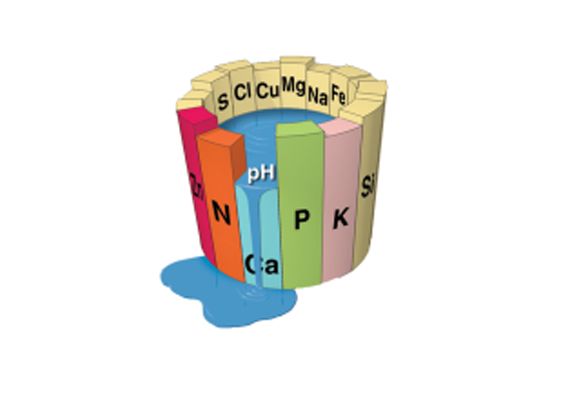
Agriculture has a lot in common with chemistry, especially when it comes to fertilizers. Plants require many elements for proper growth and development, starting from yield-forming elements such as nitrogen, phosphorus, and potassium, to micronutrients, which surprisingly also play a significant role in shaping the yield. According to Liebig's Law of the Minimum, the yield of crops depends on the element that is in the lowest quantity in the soil relative to the plants' nutritional needs. However, elements do not occur individually but in the form of chemical compounds, and these can react in a way that may result in more harm than benefit.
For liming to have the desired effect, not only in terms of raising the pH but also in significantly improving the assimilation of the main yield-forming elements - NPK, knowledge of how fertilizers acidify our soil and how they react with CaCO3 is necessary.
Nitrogen - N
Fertilizers containing nitrogen can be divided into several groups: ammonium fertilizers (containing the -NH4 group), nitrate fertilizers (containing the acidic residue -NO3), ammonium nitrate fertilizers (containing ammonium nitrate - NH4 NO3), and amide fertilizers (containing the amide form of nitrogen -NH2). It should be noted that not every nitrogen fertilizer acidifies the soil. The soil undergoes the greatest acidification from ammonium fertilizers, slightly less from ammonium nitrate fertilizers (e.g., ammonium nitrate), while nitrate remains neutral to soil pH. Amide fertilizers include urea, which has a slightly different mechanism of action, acts more slowly, and shortly after its application, the soil pH slightly increases, but further urea transformations cause a decrease in pH, so this fertilizer is classified as acidifying the soil. Nitrogen compounds in the soil undergo various oxidation and reduction reactions, resulting in either form assimilable by plants or, conversely, gaseous forms that, when released into the atmosphere, result in losses of this valuable element for plants.
Third-generation Polcalc Lime should not be mixed with fertilizers containing nitrogen in the ammonium form, as this results in nitrogen losses. The released free ammonia acts toxic to plants, especially in the early growth stage.
Phosphorus - P
Phosphorus is an essential element for plants throughout the entire vegetative period, but there are several critical phases when this element plays a particularly important role:
- Initial development, i.e., root and above-ground shoot formation
- Spring vegetation starts in winter crops
- Flowering and seed or grain ripening.
Three forms of phosphorus occurrence in the soil are distinguished (division based on availability to plants): active phosphorus, mobile phosphorus, and reserve phosphorus. Active phosphorus occurs in the soil solution and is a form directly available to plants, but there is not enough of it to meet their nutritional needs. During plant growth, mobile phosphorus can also be activated, which will replenish the deficiency of this element, but this process (desorption) occurs under conditions of appropriate pH - from slightly acidic to neutral. In strongly acidified and alkaline soils, phosphorus retrogression occurs, i.e., a decrease in its availability to plants.
Unlike nitrogen, phosphorus is a less mobile element in the soil, so it remains in the soil layer into which it was introduced with fertilizers. It only changes its chemical form to a more or less available one for the plant. Due to its low mobility, phosphorus fertilizers are sometimes used "in reserve," pre-sowing, usually before autumn plowing. When using phosphorus fertilizers "in reserve," it is always worth remembering that on acidic and very acidic soils, usually low in available forms of phosphorus, soluble phosphates are very quickly retrogressed, even to forms that are difficult to access.
So how to use lime and phosphorus fertilizers to maximize all their functions and ensure the best possible absorption of introduced nutrients?
First of all, phosphorus-containing fertilizers soluble in water should not be mixed with fertilizers containing calcium. Under these conditions, phosphates are retrogressed into an insoluble form in water. The optimal solution will be to take care of the optimal soil pH in advance so that plants during the vegetative phase can use the largest available form of the element.
Potassium - K
In contrast to phosphorus, potassium is almost entirely associated with the mineral part of the soil. In Poland, there is a very large proportion of soils with very low and low availability of assimilable potassium, hence it is important to supply this element in fertilizers. However, there are no clear contraindications to the use of calcium and potassium fertilizers in succession. The optimal pH range, which enables the best potassium uptake by plants, is between 5.5-7.2.
Remember about the functions of fertilizers!
When planning fertilization, it is always important to remember what effect we want to achieve: whether we want to provide essential nutrients to plants or whether we intend to ensure suitable soil conditions. Slightly acidic and neutral soil pH is the foundation on which further NPK fertilization plans should be built. If we do not take care of the correct soil pH at the right time, we will likely waste a significant portion of the money allocated to nitrogen, phosphorus, or multicomponent fertilizers. May the above information translate into the highest yields and the lowest losses of nutrient components!






